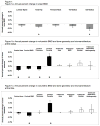Rapid cortical bone loss in patients with chronic kidney disease
- PMID: 23456850
- PMCID: PMC3720694
- DOI: 10.1002/jbmr.1916
Rapid cortical bone loss in patients with chronic kidney disease
Abstract
Chronic kidney disease (CKD) patients may have high rates of bone loss and fractures, but microarchitectural and biochemical mechanisms of bone loss in CKD patients have not been fully described. In this longitudinal study of 53 patients with CKD Stages 2 to 5D, we used dual-energy X-ray absorptiometry (DXA), high-resolution peripheral quantitative computed tomography (HRpQCT), and biochemical markers of bone metabolism to elucidate effects of CKD on the skeleton. Median follow-up was 1.5 years (range 0.9 to 4.3 years); bone changes were annualized and compared with baseline. By DXA, there were significant declines in areal bone mineral density (BMD) of the total hip and ultradistal radius: -1.3% (95% confidence interval [CI] -2.1 to -0.6) and -2.4% (95% CI -4.0 to -0.9), respectively. By HRpQCT at the distal radius, there were significant declines in cortical area, density, and thickness and increases in porosity: -2.9% (95% CI -3.7 to -2.2), -1.3% (95% CI -1.6 to -0.6), -2.8% (95% CI -3.6 to -1.9), and +4.2% (95% CI 2.0 to 6.4), respectively. Radius trabecular area increased significantly: +0.4% (95% CI 0.2 to 0.6), without significant changes in trabecular density or microarchitecture. Elevated time-averaged levels of parathyroid hormone (PTH) and bone turnover markers predicted cortical deterioration. Higher levels of serum 25-hydroxyvitamin D predicted decreases in trabecular network heterogeneity. These data suggest that significant cortical loss occurs with CKD, which is mediated by hyperparathyroidism and elevated turnover. Future investigations are required to determine whether these cortical losses can be attenuated by treatments that reduce PTH levels and remodeling rates.
Keywords: CHRONIC KIDNEY DISEASE; CORTICAL BONE; DXA; HRpQCT; RENAL OSTEODYSTROPHY.
Copyright © 2013 American Society for Bone and Mineral Research.
Conflict of interest statement
All authors state that they have no conflicts of interest
Figures


References
-
- Kaji H, Yamauchi M, Yamaguchi T, Shigematsu T, Sugimoto T. Mild Renal Dysfunction Is a Risk Factor for a Decrease in Bone Mineral Density and Vertebral Fractures in Japanese Postmenopausal Women. The Journal of clinical endocrinology and metabolism 2010 - PubMed
-
- Ball AM, Gillen DL, Sherrard D, Weiss NS, Emerson SS, Seliger SL, Kestenbaum BR, Stehman-Breen C. Risk of Hip Fracture Among Dialysis and Renal Transplant Recipients. JAMA: The Journal of the American Medical Association. 2002;288(23):3014–8. - PubMed
-
- Nickolas TL, McMahon DJ, Shane E. Relationship between Moderate to Severe Kidney Disease and Hip Fracture in the United States. J AmSocNephrol. 2006;17(11):3223–32. - PubMed
-
- Fried LF, Biggs ML, Shlipak MG, Seliger S, Kestenbaum B, Stehman-Breen C, Sarnak M, Siscovick D, Harris T, Cauley J, Newman AB, Robbins J. Association of kidney function with incident hip fracture in older adults. J AmSocNephrol. 2007;18(1):282–6. - PubMed
-
- Nitsch D, Mylne A, Roderick PJ, Smeeth L, Hubbard R, Fletcher A. Chronic kidney disease and hip fracture-related mortality in older people in the UK. Nephrol Dial Transplant. 2009;24(5):1539–44. - PubMed
Publication types
MeSH terms
Substances
Grants and funding
LinkOut - more resources
Full Text Sources
Other Literature Sources
Medical

